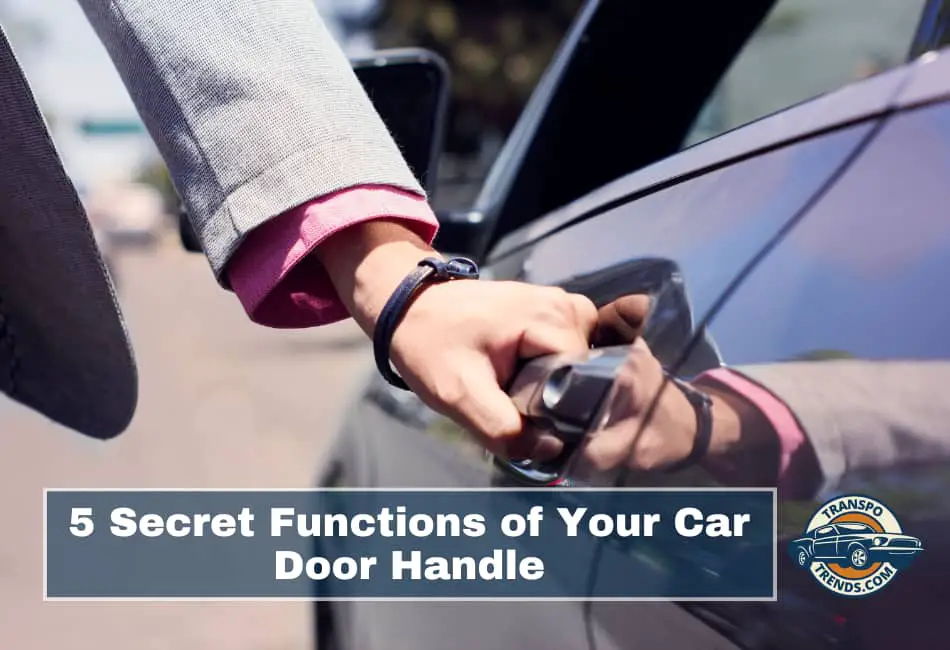Door handles might seem like one of the most basic parts of your vehicle. You pull them to get in or out—simple, right? But what if I told you that your car’s door handles can do much more than that?
From preventing costly scratches to improving your driving judgment, there is a lot more utility packed into those handles than meets the eye.
If you learn these five smart functions, not only will you avoid scratching your car doors when parking close to others, but you will also maneuver with more confidence and awareness.
Let us dive deep into these surprising uses and how to practice them in real-world situations.
1. Prevent Scratches When Exiting Your Car
One of the most frustrating things for car owners is discovering a fresh scratch on the edge of their car door. It often happens when parked in tight spots, especially in urban areas or crowded supermarket lots.
The door bangs against a neighboring vehicle or even a wall—and you are left with an unsightly mark. Here is a simple fix using your door handle as a spatial guide:
When you park next to another vehicle, line up your door handle with the door frame of the car beside you.
Once both are on the same horizontal plane, it does not matter how far you swing the door open—it will not hit the adjacent car. This positioning trick uses the handle’s alignment to estimate a safe buffer zone.
This tip is particularly handy when parking in narrow garages or beside tall curbs. It is like having an invisible ruler every time you open your door.
2. Adjust Rearview Mirrors for Maximum Visibility Using the Door Handle
Believe it or not, your front door handle plays a vital role in helping you align your rearview mirrors for the best field of vision.
- For the left rearview mirror, position the front door handle in the lower right corner of the mirror frame.
- For the right rearview mirror, align the front door handle to the lower left corner.
This method gives you a wide yet accurate visual angle to spot roadside steps, lane markers, or vehicles sneaking into your blind spot.
Properly adjusted mirrors not only increase safety but also reduce the stress of constantly having to crane your neck when changing lanes or backing up.
3. Know Exactly When to Brake by Watching the Handle Disappear
Have you ever followed a car too closely and wondered if you are about to rear-end it? Your door handle can offer a silent cue here as well.
When you are trailing a car and the vehicle’s door handle disappears from your view, that is your sign to brake immediately.
This means the gap between your car and theirs is now around 10 centimeters—too close for comfort.
This habit of watching the handle as a visual distance indicator is far more intuitive than trying to guess based on bumper alignment or road markings.
It could help you avoid low-speed collisions that result in expensive insurance claims or dent repairs.
4. Use the Handle to Park at the Perfect Distance From the Curb or Wall
Backing into a parking space with precision is not as easy as it looks, especially when you are trying to avoid bumping into a curb or step.
Here is a technique to help:
When the middle position of the front door handle visually aligns with the edge of the step or curb in your rearview mirror, your car is exactly 30 centimeters from the object.
This spacing is perfect. It is close enough for safe clearance and stability, but far enough to avoid tire or bumper damage.
This trick is especially helpful when parking beside high sidewalks or stone curbs that can scratch your vehicle’s underbody or wheels.
Using a door handle as a distance marker gives you a consistent, repeatable parking strategy—no need to rely on gut feeling or trial and error.
5. Prevent Visibility Issues and Improve Roadside Awareness
When paired with proper mirror adjustments (as explained in point two), the door handle can also serve as a spatial benchmark for vehicle positioning.
For example, when reversing into a narrow lane or approaching a tight driveway, keep an eye on how the door handle moves in relation to pavement lines, barriers, or parked cars.
If the handle begins to disappear or shift quickly out of view, you know you are veering too close or at the wrong angle.
Some driving instructors even use the door handle as a coaching aid to teach students how to maintain proper lateral distance when overtaking cyclists or navigating between cones during parking exams.
Final Thoughts
Understanding the multiple roles of your car’s door handle helps you:
- Avoid unnecessary repair costs caused by door scratches.
- Improve mirror setup and lane awareness.
- Prevent fender-benders caused by poor distance judgment.
- Execute better parking decisions, even in tight spots.
- Drive with a more analytical and confident mindset.
These small adjustments make a big difference over time. While cars today come packed with sensors, cameras, and alerts, your door handle—an often overlooked, mechanical component—remains one of the most reliable visual tools for everyday driving.
Quick Recap
| Function of Door Handle | What to Look For | Practical Outcome |
|---|---|---|
| Opening Door Without Scratches | Align handle with door frame of nearby car | Prevents contact with adjacent vehicles |
| Adjusting Rearview Mirrors | Position door handle in the mirror’s lower corners | Enhances visibility and eliminates blind spots |
| Judging Distance When Following | Brake when door handle vanishes from view | Keeps 10 cm safe stopping distance |
| Parking Distance from Steps | Handle aligned with step = 30 cm from it | Prevents rim and underbody damage |
| Visual Reference While Driving | Use handle to gauge space in tight maneuvers | Improves spatial awareness and parking efficiency |

